Celebrating 85 Years
Founded in 1931, Universal Builders Supply, Inc. (UBS) has worked on some of the country’s most recognizable and treasured structures. Each generation of this three-generational company has had a pet project to be proud of, starting with the Empire State Building, one of the few construction jobs in New York City during the Depression, to Yankee Stadium, the Washington Monument, and the Statue of Liberty. To celebrate it’s 85th year in 2016, UBS posted 85 Fun Facts about some of the most iconic and historic building projects. Here they are:
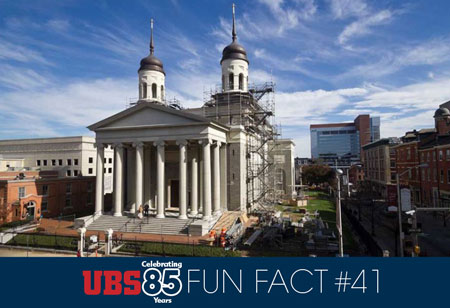
Post 41: The Baltimore Basilica, Baltimore, MD
The Basilica of the National Shrine of the Assumption of the Blessed Virgin Mary, also called the Baltimore Basilica, was designed in the early 1800s by Benjamin Latrobe and was America’s first cathedral. A 32-month, $34 million restoration project was completed in 2006, in which UBS literally “raised the roof” four feet to allow trades adequate room to reconstruct and restore the roof. UBS used hydraulic jacks placed on temporary support beams directly below the roof to lift it and then installed a skirt to maintain a weather tight enclosure. Once the original lower roof was completed, the upper roof was cut in sections and removed by crane.
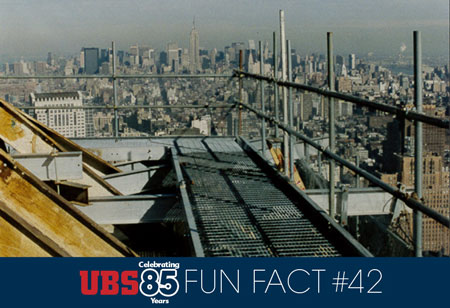
Post 42: The American Express Tower, NYC
American Express Tower, nicknamed for being the headquarters of American Express, is located in the World Financial Center in lower Manhattan. Designed by Cesar Pelli & Associates, it’s a great example of postmodern architecture and at 739 feet, it’s the 40th tallest building in NYC. Also known as 200 Vesey Street, it contains 2.1 million square feet of rentable office space. In 1992, UBS installed a scaffold deck and netting around the perimeter of the roof so workers could perform necessary repairs.
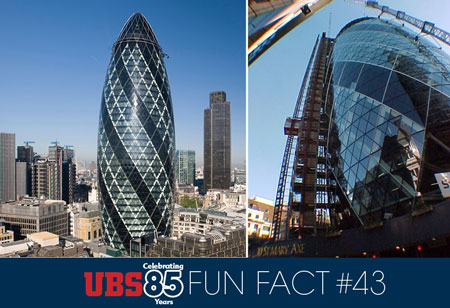
Post 43: Swiss Re Building, London, UK
The Swiss Re Building, known as The Gherkin, is a commercial neo-futuristic skyscraper located in London’s financial district. The building’s circumference is 584 feet at its widest part—only 6.5 feet less than its height, and each floor rotates five degrees from the one below to create its cylindrical shape. It has won a number of awards for architecture and is now an iconic symbol of London, and one of the city’s most widely recognized examples of contemporary architecture. UBS installed a dual hoist during construction where the runways from the hoist to the building were engineered to vary in length due to the unique circumference of the building.
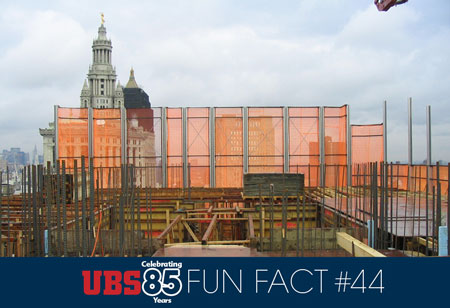
Post 44: The UBS Cocoon
Universal Builders Supply Inc, holds a patent on the UBS Cocoon, a protection system developed in 2004. It is used during concrete construction and designed to enable tall buildings to be built more safely, quickly, and economically in busy congested areas. Consisting of vertical panels, solid horizontal flaps, and a secondary safety net, the system is designed to provide fall protection and debris containment. The UBS Cocoon helps ensure a safer working environment for both workers and pedestrians. Photo shows cocoon installation at the Beekman project—8 Spruce Streett—with the Municipal Building in the background.
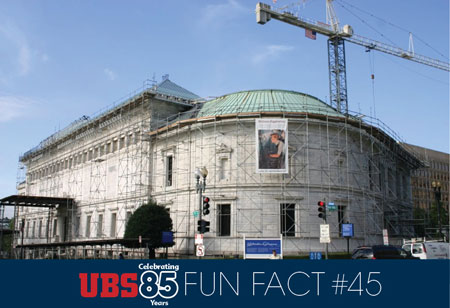
Post 45: Corcoran Gallery of Art, Washington, DC
The Corcoran Gallery of Art in Washington DC was founded in 1869 by William Wilson Corcoran, co-founder of Riggs Bank, and was one of the first fine art galleries in the United States. Construction of its original building began before the start of the Civil War, and was used as a warehouse during the war. After the gallery outgrew its first home in 1897, a new building was constructed; designed by Ernest Flagg in the Beaux Arts style. In 1928, the Corocoran built a new wing designed by Charles Adam Platt for the art collection of former Senator William A. Clark. Another wing designed by Frank Gehry in the early 2000’s, was not built due to lack of funding. The gallery closed in 2014 and the building is now part of the George Washington University’s new Corcoran School of the Arts and Design. In 2009, UBS provided scaffold access to skylight and exterior with a custom-designed rolling roof rig for weather enclosure during skylight replacement.
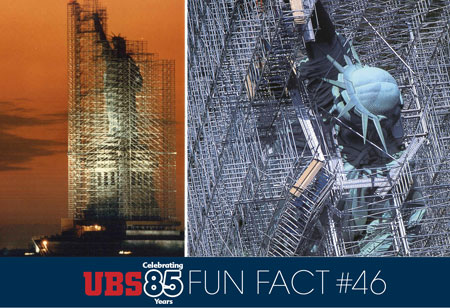
Post 46: Statue of Liberty—Scaffolding, NYC
In celebration of USA’s recent Independence Day, this week’s UBS85 posts will be about UBS’s most prominent restoration project—the Statue of Liberty. The monument was designed by French sculptor Frederic Bartholdi and based on Libertas, the Roman goddess of liberty. Originally assembled on its pedestal in NYC after being constructed in France and sent to the United States in crates in 1884, the statue was dedicated on Oct. 28, 1886. Ninety-eight years later tourists who visited Liberty Island in 1984–1986 were greeted by Lady Liberty encased in an aluminum cage. The “cage” was scaffolding used by workers performing the restoration work. UBS made it into the Guinness Book of World Records for building the tallest free-standing scaffold for the restoration.
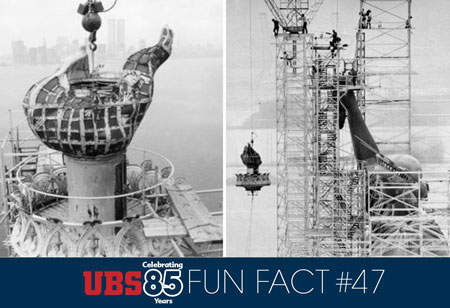
Post 47: Statue of Liberty—Lowering the Torch, NYC
As part of the Statue of Liberty restoration, the lowering of the original 98-year-old torch took place on July 4, 1984, accompanied by a patriotic ceremony attended by more than 4,000 people on Liberty Island. Officiated by Mayor Ed Koch, it marked the 100th anniversary of France’s presentation of Lady Liberty to the United States. The challenge was since no one knew the torch's weight, a dynamometer (scale) had to be attached to the crane’s hook to calculate the weight (3,600 pounds) before lifting it as “God Bless America” played in the background and safely lowering it to the ground as boats in the harbor saluted with horns blowing. The crane had the capacity to lift 12 times that weight, but everyone at UBS was pleased when the torch finally touched down. The original torch is on display in the museum at the Statue's base.
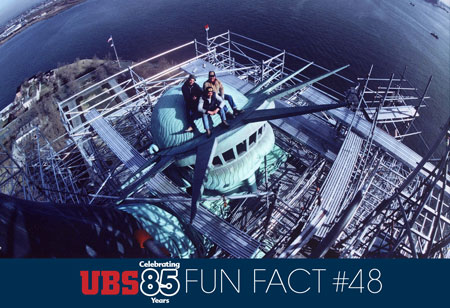
Post 48: Statue of Liberty—The Crown, NYC
The only access to the Statue of Liberty’s torch is via a winding steel ladder that extends up through the statue’s arm, beginning in the crown. Tourists used to be able to climb up to the torch until 1916, when those privileges were revoked due to safety concerns. Before the restoration, the arm and the torch were so loose that they waved up to 15 inches from side-to-side when it was windy. UBS was awarded the scaffolding contract after outbidding the competition for the sturdiest and least obtrusive scaffolding design, conceived of by Alan Shalders, UBS chief engineer. Able to withstand winds of up to 100 miles an hour, the scaffolding used over 300 tons of aluminum to surround the statue with 1,000 aluminum frames each 6 feet high and 6 feet wide.
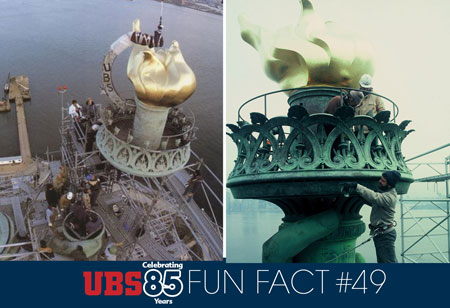
Post 49: Statue of Liberty—Installing the New Torch, NYC
As part of the #restoration of the Statue of Liberty in 1984, UBS installed a new torch. The new one is gold-plated, and is designed to reflect the light of the sun during the day, and the quartz-iodine lamps at night. The new torch of was attached by hundreds of small copper rivets between the base of the torch and the arm of the statue. A little-known accessory that UBS was asked to provide for the new torch is a maintenance platform with an enclosure. This addition seals the entire flame from the outside elements, and allows further work to be done on the torch as necessary.
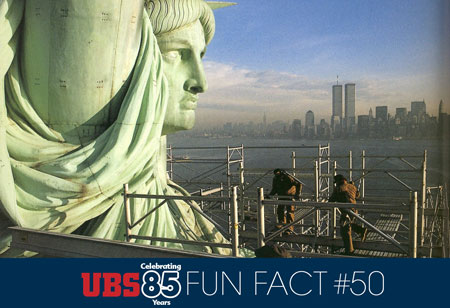
Post 50: Statue of Liberty—New UBS Logo
After UBS was awarded the epic honor of helping to restore the Statue of Liberty in 1984, they included the American icon as an official part of the company logo. At the time, the main office was located in Mount Vernon, where the property included a 175-year-old horse stable, which workers used to store nuts and bolts for construction projects. The company displayed its pride in the project by installing a large sign over the warehouse door with the new logo of Lady Liberty.
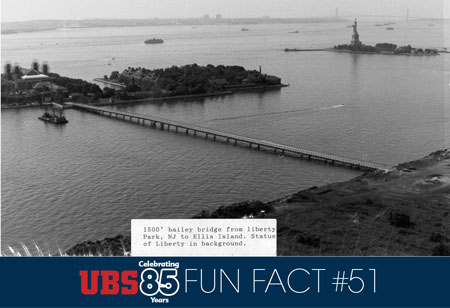
Post 51: Statue of Liberty—Ellis Island Bridge, NYC
In order to transport equipment and materials to the Statue of Liberty for its restoration, UBS designed and built the Ellis Island Bridge. The bridge was constructed to be low and light-weight, inspired by the Army Corps of Engineers in WWII. It didn’t have to be high since passing ships travel on the opposite side of the island. During the course of the monument’s restoration, UBS drove pick-up trucks full of supplies over that bridge, and it remains installed to this day.
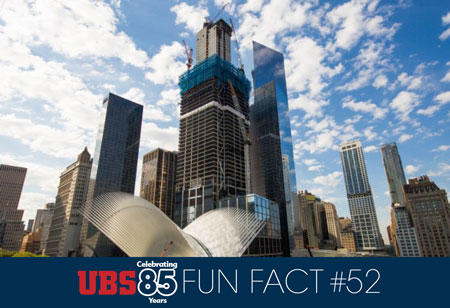
Post 52: 3 World Trade Center, NYC
Three World Trade Center was designed by Pritzer Prize-winning architect Richard Rogers to be respectful of the World Trade Center Memorial Plaza that sits across the street. Rising to 1,079 feet with 80 stories when completed with approximately 2,000,000 square feet of office and retail space, it will serve as the complex's commerical core. The building’s design is intimately related to and inspired by the other structures within the World Trade Center complex. The building’s central zone reduces in mass as it rises towards the sky to complement the surrounding public space. The building is slated to be completed in 2018, and this past June 23rd a topping-out ceremony was held to celebrate the project’s progress.
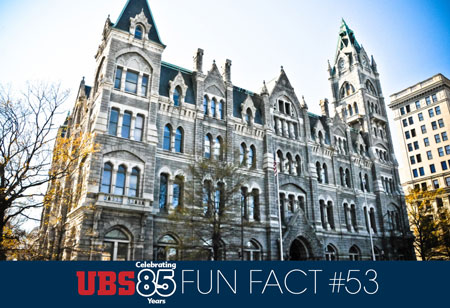
Post 53: Old City Hall, Richmond, VA
Old City Hall in Richmond, Virginia is a masterpiece of High Victorian Gothic design by Elijah E. Myers. It served as City Hall from 1894 through the 1970s. Dominated by two large asymmetrical towers, it is recognized by its 195-foot high clock tower. The stone exterior is beautifully detailed ashlar with buttresses and pointed arches, measures 170 feet by 140 feet and features an impressive skylighted central court surrounded by arcaded galleries. It occupies its own city block in downtown Richmond, and is listed in the National Register of Historic Places, and was designated a U.S. National Historic Landmark for its architecture. Old City Hall survived at least two proposals to demolish it, and was subsequently restored in the 1980s, a significant preservation victory. UBS provided hoisting, access scaffold, and sidewalk bridge during the restoration project in 2003.
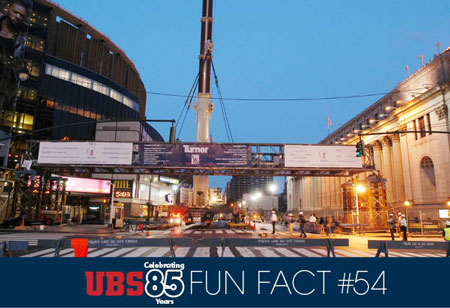
Post 54: Republican National Convention Bridge at MSG, NYC
In 2004, the Republican National Convention was held at Madison Square Garden in NYC. The RNC resulted in the confirmation of the nomination of President George W. Bush and Vice President Dick Cheney for reelection. In order to accommodate the media and Convention participants, UBS installed a temporary pedestrian bridge 17 feet above 8th Avenue at West 33rd Street to connect MSG to the James A. Farley Post Office, providing fast passage from the media center to the arena. The bridge measured 20 feet by 110 feet long and weighed 30 tons. UBS installed, transported, rigged, and ultimately dismantled and removed the media bridge, which involved working closely with the NYC DOT on lane and street closures. The bridge was transported in sections and loaded onto three flatbed trucks then lifted into place during off peak hours.
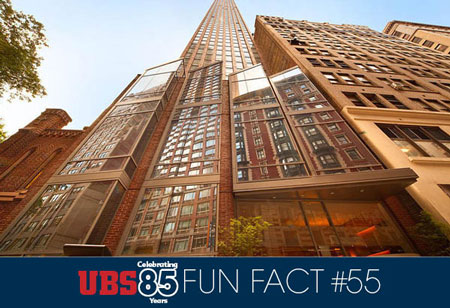
Post 55: Sky House —11 East 29th Street, NYC
Sky House is a residential tower in Manhattan designed by award-winning architect Bruce Fowle of FXFOWLE Architects. Built in 2008 and located in the Flatiron District in the NoMad neighborhood (north of Madison Avenue), the soaring 55-story tower is constructed out of red brick and recalls elements of classic New York City.
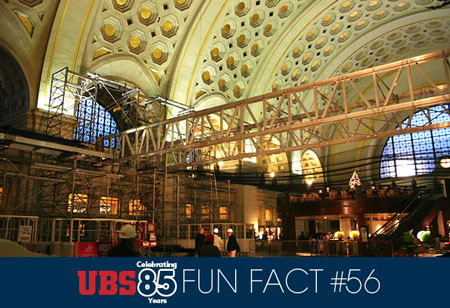
Post 56: Union Station, Washington, DC
Union Station is Washington DC’s main train station and transportation hub visited by over 40 million people a year. The historic building was designed by architect Daniel H. Burnham, and opened in 1907. It’s one of the finest examples of the Beaux-Arts style of architecture with 96-foot barrel-vaulted ceilings, stone inscriptions, and use of white granite, marble, and gold leaf. In the 1970s, the building was uninhabitable and in danger of demolition. It was designated a historic landmark and restored in 1988. In July 2012, Amtrak announced a four-phase, $7 billion plan to revamp and renovate the station further over 15 to 20 years.
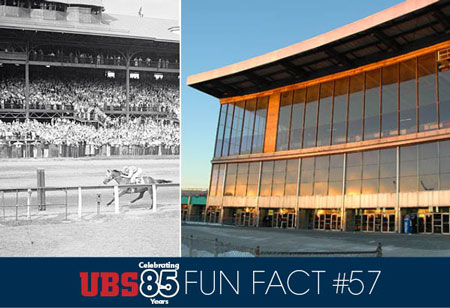
Post 57: Yonkers Raceway, Yonkers, NY
Yonkers Raceway, founded in 1899 as the Empire City Racetrack, is a one-half-mile standard bred harness racing dirt track and slots racino. One of Yonkers’ city landmarks, the raceway was opened in 1899 by William H. Clark’s Empire City Trotting Club. Many famous thoroughbreds have raced there, including Seabiscuit, whose unexpected successes made him a media sensation during the Great Depression, and inspired a best-selling book and Academy Award-nominated film in 2003. In 2006, Yonkers Raceway debuted a $225 million renovation to the Empire City Casino designed by Ewing Cole adding 7,500 high-tech slot machines. In January 2013, a $50 million expansion designed by Studio V Architecture was completed adding 66,000 sq. ft. to the casino. The casino is now the largest private employer in Yonkers. UBS provided shoring and access scaffold to Yonkers Raceway during the Casino Installation.
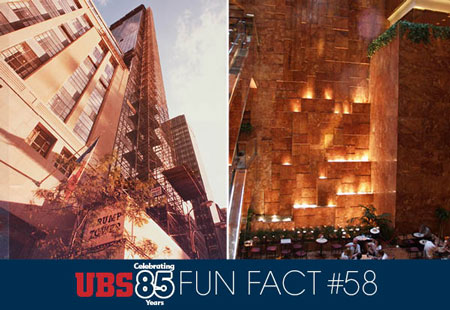
Post 58: Trump Tower, NYC
Trump Tower, home to Donald Trump and the corporate offices of The Trump Organization, is one of Manhattan’s most iconic buildings. Completed in 1984, the 58-story mixed-use structure was designed by architect Der Scutt, and housed the headquarters of the 2016 Donald Trump presidential campaign. Constructed on the former site of the Bonwit Teller flagship store, an architecturally renowned building, the tower is known for its massive five-story atrium that features a 60-foot high waterfall. UBS provided a sidewalk bridge and dual rack and pinion hoist that serviced all 58 floors of Trump Tower during its erection, which was completed in 1984.
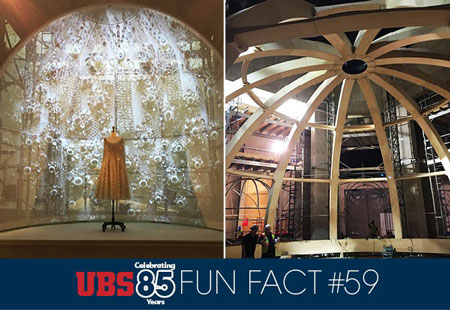
Post 59: The MET’s Manus x Machina, NYC
UBS has a long history of projects with the Metropolitan Museum of Art and was called upon once again to erect one of its most complex scaffold installations to date for the “Manus X Machina: Fashion in an Age of Technology” exhibit. Presented in the Robert Lehman Wing, the scaffold took a month to install and could be seen through the transparent white fabric behind each display. At the center of the exhibit is a large dome, which UBS erected and hoisted into place. A wedding dress Karl Lagerfeld designed for Chanel with a 20-foot train, occupies the space with details of the embroidery projected onto the domed ceiling. The exhibit is on view from May 5 through September 5, 2016.
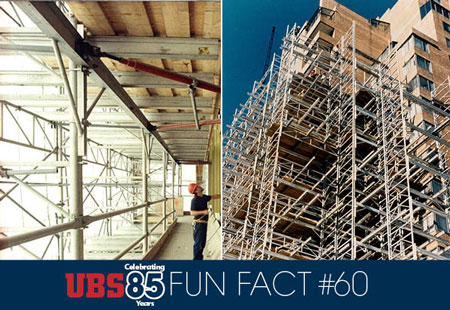
Post 60: Harper House, Columbia, MD
Harper House is a groundbreaking housing collaboration that created high-quality and innovative affordable housing for families in Columbia, Maryland. UBS provided hoisting and access scaffolds so workers could remove all the existing exterior brick work and replace it with a new façade in the early 1980s. In 2011, Harper House substantially renovated all existing apartments, and constructed a nine-story addition to provide larger units for families. Through work with Habitat America and the United States Department of Housing and Urban Development, the apartments serve households earning 60% of area median income (AMI) or below. Harper House is unique for the way it’s well-integrated into the surrounding neighborhood, with walking access to public transportation and neighborhood shopping. It also meets the Enterprise Green Communities Criteria!